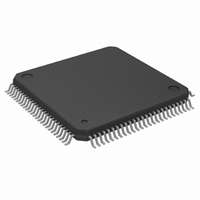LPC47B272-MS SMSC, LPC47B272-MS Datasheet - Page 51

LPC47B272-MS
Manufacturer Part Number
LPC47B272-MS
Description
IC CTRLR SUPER I/O LPC 100-QFP
Manufacturer
SMSC
Datasheet
1.LPC47B272-MS.pdf
(195 pages)
Specifications of LPC47B272-MS
Controller Type
I/O Controller
Interface
LPC
Voltage - Supply
3.3V
Current - Supply
15mA
Operating Temperature
0°C ~ 70°C
Mounting Type
Surface Mount
Package / Case
100-QFP
Lead Free Status / RoHS Status
Lead free / RoHS Compliant
Other names
638-1019
Available stocks
Company
Part Number
Manufacturer
Quantity
Price
Company:
Part Number:
LPC47B272-MS
Manufacturer:
ADI
Quantity:
957
Company:
Part Number:
LPC47B272-MS
Manufacturer:
Microchip Technology
Quantity:
10 000
Part Number:
LPC47B272-MS
Manufacturer:
SMSC
Quantity:
20 000
EFIFO - A "1" disables the FIFO (default). This means data transfers are asked for on a byte-by-byte basis. Defaults to
"1", FIFO disabled. The threshold defaults to "1".
POLL - Disable polling of the drives. Defaults to "0", polling enabled. When enabled, a single interrupt is generated
after a reset. No polling is performed while the drive head is loaded and the head unload delay has not expired.
FIFOTHR - The FIFO threshold in the execution phase of read or write commands. This is programmable from 1 to 16
bytes. Defaults to one byte. A "00" selects one byte; "0F" selects 16 bytes.
PRETRK - Pre-Compensation Start Track Number. Programmable from track 0 to 255. Defaults to track 0. A "00"
selects track 0; "FF" selects track 255.
Version
The Version command checks to see if the controller is an enhanced type or the older type (765A). A value of 90 H is
returned as the result byte.
Relative Seek
The command is coded the same as for Seek, except for the MSB of the first byte and the DIR bit.
DIR
RCN
The Relative Seek command differs from the Seek command in that it steps the head the absolute number of tracks
specified in the command instead of making a comparison against an internal register. The Seek command is good for
drives that support a maximum of 256 tracks. Relative Seeks cannot be overlapped with other Relative Seeks. Only
one Relative Seek can be active at a time. Relative Seeks may be overlapped with Seeks and Recalibrates. Bit 4 of
Status Register 0 (EC) will be set if Relative Seek attempts to step outward beyond Track 0.
As an example, assume that a floppy drive has 300 useable tracks. The host needs to read track 300 and the head is
on any track (0-255). If a Seek command is issued, the head will stop at track 255. If a Relative Seek command is
issued, the FDC will move the head the specified number of tracks, regardless of the internal cylinder position register
(but will increment the register). If the head was on track 40 (d), the maximum track that the FDC could position the head
on using Relative Seek will be 295 (D), the initial track + 255 (D). The maximum count that the head can be moved with
a single Relative Seek command is 255 (D).
The internal register, PCN, will overflow as the cylinder number crosses track 255 and will contain 39 (D). The resulting
PCN value is thus (RCN + PCN) mod 256. Functionally, the FDC starts counting from 0 again as the track number goes
above 255 (D). It is the user's responsibility to compensate FDC functions (precompensation track number) when
accessing tracks greater than 255. The FDC does not keep track that it is working in an "extended track area" (greater
than 255). Any command issued will use the current PCN value except for the Recalibrate command, which only looks
for the TRACK0 signal. Recalibrate will return an error if the head is farther than 79 due to its limitation of issuing a
maximum of 80 step pulses. The user simply needs to issue a second Recalibrate command. The Seek command and
implied seeks will function correctly within the 44 (D) track (299-255) area of the "extended track area". It is the user's
responsibility not to issue a new track position that will exceed the maximum track that is present in the extended area.
To return to the standard floppy range (0-255) of tracks, a Relative Seek should be issued to cross the track 255
boundary.
A Relative Seek can be used instead of the normal Seek, but the host is required to calculate the difference between the
current head location and the new (target) head location. This may require the host to issue a Read ID command to
ensure that the head is physically on the track that software assumes it to be. Different FDC commands will return
different cylinder results which may be difficult to keep track of with software without the Read ID command.
SMSC LPC47B27x
Relative Cylinder Number that determines how many tracks to step the head in or out from the current track
number.
Head Step Direction Control
DIR
0
1
DATASHEET
Step Head Out
Step Head In
- 51 -
ACTION
Rev. 04-17-07













